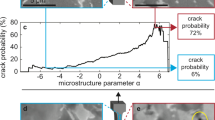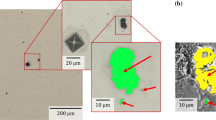Abstract
The fractural behavior of multi-phase materials is not well understood. Therefore, a statistic study of micro-failures is conducted to deepen our insights on the failure mechanisms. We systematically studied the influence of the morphology of dual phase (DP) steel on the fracture behavior at the onset in two ways: (i) in a numerical setting by statistically averaging over the micro-structural arrangements around the damage sites in no less than 400 randomly-generated idealized microstructural models loaded in pure shear; and (ii) in an experimental setting by statistically averaging, similar to the numerical simulations, over the damage sites found in a large collection of large field-of-view SEM images of DP steel deformed in uniaxial tension, where deliberately-overexposed backscattered electron images sharply mark the damage location, while simultaneously-recorded secondary electron images are used to identify the material phases. The numerical and experimental analyses were validated and tested for accuracy. Application of both techniques to DP showed a similar single topological feature to be most sensitive to damage: a small region of soft matrix material with hard inclusion particles on opposing sides. These results are representative for and yield insight in damage evolution in a wide variety of multi-phase materials.
Access provided by Autonomous University of Puebla. Download conference paper PDF
Similar content being viewed by others
Keywords
8.1 Introduction
Dual phase (DP) steel is applied widely in the automotive industry because of its mechanical properties: high strength-to-weight ratio, high strength and ductility at the same time, low yield-to-ultimate strength ratio and good formability. However, the fractural behavior of DP steel is not understood completely. Debate over critical failure mechanism still remains. Therefore, a statistic study of micro-failures is conducted to deepen our insights on the failure mechanisms. We systematically study the influence of the morphology of DP steel on the fracture behavior at the onset in two ways: (i) in a numerical setting by averaging over the damage sites in a large collection of randomly-generated idealized microstructural models loaded in pure shear [1] and (ii) in an experimental setting by averaging over the damage sites found in a large collection of large field-of-view SEM images of DP steel deformed in uniaxial tension.
8.2 Numerical Damage Characterization
The numerical model is highly idealized to determine the influence of geometrical arrangement of the hard phase on the fractural behavior independently from other influences. This influence has been studied in a structural fashion, which is not easily achieved experimentally, or with realistic microstructures: 400 microstructures of a two-phase material are randomly generated and numerically deformed under pure shear assuming, for both phases an isotropic elasto-plastic constitutive model but with different initial yield stresses and hardening laws and using periodic boundary conditions, see Fig. 8.1. The onset of damage is signaled using a simple indicator, which depends linearly on the effective plastic strain and the non-negative part of the hydrostatic stress. The 400 micro-structural arrangements around the damage sites are statistically averaged, as explained in Fig. 8.2.
(Top) Three examples of the 400 randomly-generated micro-structural two-phase arrangements, which have been numerically deformed under pure shear. (Bottom) Maps of the damage indicator after deformation; the damage indicator depends linearly on the effective plastic strain and the non-negative part of the hydrostatic stress
The average indicator function weighted by the damage in each element (of all 400 random cells). The origin is arbitrarily chosen in the center. Notice that the neutral color is chosen to coincide with the volume fraction of hard phase, which is 0.25 for martensite in dual phase steel; red and blue indicate, respectively, an elevated likelihood of hard and soft phase
8.3 Experimental Damage Characterization
In the experimental work, deformed DP steel DP600 specimens are observed using an intelligent SEM imaging strategy, in which secondary electron (SE) and backscattered electron (BSE) images are taken simultaneously in each scan such that the pixels in SE and BSE images at the same position match each other exactly. While the SE images are used to identify the material phases, see Fig. 8.3a, the BSE images are deliberately overexposed in such a way that the topography contrast between ferrite and martensite disappears such that the locations of micro-failures are easily identified, see Fig. 8.3b. A Matlab program automatically processes both BSE images and SE images to identify the failure mechanisms and phases. Particularly, the white edges around the damage sites, which would disrupt the statistical averaging, are automatically identified and turned into the neutral grey value, see Fig. 8.4. Finally, the SE images are used to automatically average the micro-structural arrangements around the damage sites, similar to the numerical simulations, see Fig. 8.5.
The SE images, corrected for the white edges around the damage sites (see Fig. 8.4) are directly averaged, by superposing the grey value distribution around each damage sites. Notice that the neutral color is chosen to coincide with the volume fraction of hard phase, which is 0.25 for martensite in dual phase steel; red and black indicate, respectively, an elevated likelihood of martensite and ferrite phase
8.4 Discussion
A single topological feature was found which is most sensitive to damage, see Figs. 8.2 and 8.5. In this feature, a small region of soft matrix material has hard inclusion particles on opposing sides. A similar observation was made by [2] for dual-phase steel, while for the special case where additional hard phase particles are located on both sides, this feature resembles the interrupted bands frequently encountered in industrial DP steel [3]. The imaging strategy applied in the experimental work shows promising result. Particularly, optimum settings for yielding simultaneously over-exposed BSE images and good-contrast SE images were found (Figs. 8.3 and 8.4), and the identification of damage sites from the SE images was carefully validated based on cross section made by focused ion beam milling (not shown). Moreover, the automatic Matlab program to identify all damage sites from the large field-of-view SEM images and statistically average over the surrounding micro-structural phases was found to operate successfully. A large amount of SEM images with proper field of view have been measured and are currently being analyzed automatically by the program. The resulting experimental image of the statistics of micro-failure (Fig. 8.5) can directly be compared to the numerical results (Fig. 8.2), a study which is ongoing. The similarities and differences between the numerical and experimental statistic damage averaging results will be discussed at the conference.
Finally, it is noted that the experiments have been focused on DP steel so far. However, these results are representative for and yield insight in damage evolution in a wide variety of multi-phase materials.
8.5 Conclusions
We systematically studied the influence of the morphology of dual phase (DP) steel on the fracture behavior at the onset in two ways: (i) in a numerical setting by statistically averaging over the micro-structural arrangements around the damage sites in 400 randomly-generated idealized microstructural models loaded in pure shear; and (ii) in an experimental setting by statistically averaging over the damage sites found in a large collection of large field-of-view SEM images of DP steel deformed in uniaxial tension. The numerical and experimental procedures and analyses were validated and tested for accuracy. Application of both techniques to DP showed a similar single topological feature to be most sensitive to damage: a small region of soft matrix material with hard inclusion particles on opposing sides. These results are representative for and yield insight in damage evolution in a wide variety of multi-phase materials.
References
de Geus, T.W.J., Peerlings, R.H.J., Geers, M.G.D.: Microstructural topology effects on the onset of ductile failure in multi-phase materials: A systematic computational approach. Int. J. Solids Struct. 67–68, 326–339 (2015)
Kadkhodapour, J., et al.: Mechanisms of void formation during tensile testing in dual-phase steel. Acta Mater. 59, 2575 (2011)
Tasan, C.C., Hoefnagels, J.P.M., Geers, M.G.D.: Microstructural banding effects clarified through micrographic digital image correlation. Scr. Mater. 62, 835–838 (2010)
Author information
Authors and Affiliations
Corresponding author
Editor information
Editors and Affiliations
Rights and permissions
Copyright information
© 2016 The Society for Experimental Mechanics, Inc.
About this paper
Cite this paper
Hoefnagels, J.P.M., Du, C., de Geus, T.W.J., Peerlings, R.H.J., Geers, M.G.D. (2016). A Statistical/Computational/Experimental Approach to Study the Microstructural Morphology of Damage. In: Beese, A., Zehnder, A., Xia, S. (eds) Fracture, Fatigue, Failure and Damage Evolution, Volume 8. Conference Proceedings of the Society for Experimental Mechanics Series. Springer, Cham. https://doi.org/10.1007/978-3-319-21611-9_8
Download citation
DOI: https://doi.org/10.1007/978-3-319-21611-9_8
Publisher Name: Springer, Cham
Print ISBN: 978-3-319-21610-2
Online ISBN: 978-3-319-21611-9
eBook Packages: EngineeringEngineering (R0)









